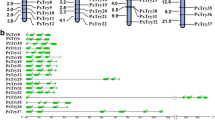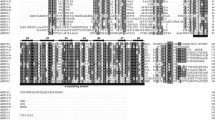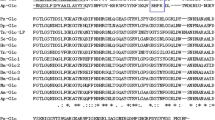Abstract
It has long been suggested that phenoloxidases (EC 1.14.18.1) are very important in a variety of biochemical processes for the successful survival of insects, including cuticular sclerotization, wound healing, and melanotic encapsulation of invading microorganisms. In this study, two prophenoloxidases (PPO, zymogen of phenoloxidase) were identified in the diamondback moth, Plutella xylostella, by native-polyacrylamide gel electrophoresis (PAGE), and their molecular masses were determined by SDS-PAGE. Their cDNAs, PxPPO1 and PxPPO2, were also cloned by reverse transcription polymerase chain reaction (RT-PCR). The full-length cDNAs of PxPPO1 and PxPPO2 encoded 682 and 696 amino acids with calculated molecular masses of 78.3 and 79.7 kDa, respectively. Deduced amino acid sequence identity between the two PxPPOs was only 48.4% whereas identities against other insect PPOs ranged from approximately 40 to 80%. Quantitative real-time PCR analysis showed that the PPO genes were expressed in all developmental stages, with the highest in prepupae; this pattern was consistent with that of PO activity. The level of expression of PxPPO1 was significantly higher than that of PxPPO2 in most developmental stages. These results offer basic knowledge for further study of the function of PPOs in P. xylostella.










Similar content being viewed by others
References
Arakane Y, Muthukrishnan S, Beeman RW, Kanost MR, Kramer KJ (2005) Laccase 2 is the phenoloxidase gene required for beetle cuticle tanning. Proc Natl Acad Sci USA 102:11337–11342
Asano T, Ashida M (2001) Cuticular pro-phenoloxidase of the silkworm, Bombyx mori. J Biol Chem 276:11100–11112
Ashida M, Brey PT (1998) Recent advances on the research of the insect prophenoloxidase cascade. In: Brey PT, Hultmark D (eds) Molecular mechanisms of immune responses in insects. Academic Publishers, London, pp 135–172
Ashida M, Yamazaki HI (1990) Biochemistry of the phenoloxidase system in insects: with special reference to its activation. In: Ohnishi E, Ishizaki H (eds) Moulting and metamorphosis. Japan Scientific Societies Press, Tokyo, pp 239–265
Barillas-Mury C (2007) CLIP proteases and plasmodium melanization in Anopheles gambiae. Trends Parasitol 23:297–299
Barrett FM, Andersen SO (1981) Phenoloxidases in larval cuticle of the blowfly, Calliphora vicina. Insect Biochem 11:17–23
Beckage NE, Thompson SN, Federici BA (1993) Parasites and pathogens of insects. Academic Press, San Diego, pp 317–342
Burmester T (2001) Molecular evolution of the arthropod hemocyanin superfamily. Mol Biol Evol 18:184–195
Chase MR, Raina K, Bruno J, Sugumaran M (2000) Purification, characterization and molecular cloning of prophenoloxidases from Sarcophaga bullata. Insect Biochem Mol Biol 30:953–967
Christensen BM, Li J, Chen CC, Nappi AJ (2005) Melanization immune responses in mosquito vectors. Trends Parasitol 21:192–199
Doucet D, Beliveau C, Dowling A, Simard J, Feng Q, Krell PJ, Cusson M (2008) Prophenoloxidases 1 and 2 from the spruce budworm, Choristoneura fumiferana: molecular cloning and assessment of transcriptional regulation by a polydnavirus. Arch Insect Biochem Physiol 67:188–201
Feng C, Song Q, Lü W, Lu J (2008) Purification and characterization of hemolymph prophenoloxidase from Ostrinia furnacalis (Lepidoptera: Pyralidae) larvae. Comp Biochem Physiol B 151:139–146
Gillespie JP, Kanost MR, Trenczek T (1997) Biological mediators of insect immunity. Annu Rev Entomol 42:611–643
Hall M, Scott M, Sugumaran M, Söderhäll K, Law JH (1995) Proenzyme of Manduca sexta phenoloxidase: purification, activation, substrate specificity of the active enzyme and molecular cloning. Proc Natl Acad Sci USA 92:7764–7768
Ishaaya I, Casida JE (1974) Dietary TH 6040 alters composition and enzyme activity of house fly larval cuticle. Pestic Biochem Physiol 4:484–490
Jiang H, Wang Y, Kanost MR (1998) Pro-phenol oxidase activating proteinase from an insect, Manduca sexta: a bacteria-inducible protein similar to Drosophila easter. Proc Natl Acad Sci USA 95(21):12220–12225
Kanost MR, Jiang H, Yu XQ (2004) Innate immune responses of a lepidopteran insect, Manduca sexta. Immunol Rev 198:97–105
Kumar S, Tamura K, Nei M (2004) MEGA3: integrated software for molecular evolutionary genetics analysis and sequence alignment. Brief Bioinform 5:150–163
Laemmli UK (1970) Cleavage of structural proteins during the assembly of the head of bacteriophage T4. Nature 227:680–685
Liang P, Meng FX, Gao XW, Zheng BZ, Cheng G (2003) Biochemical characteristics of tyrosinase in the diamondback moth, Plutella xylostella (L.). Acta Entomol Sinica 46:553–557
Ling E, Yu X (2005) Prophenoloxidase binds to the surface of hemocytes and is involved in hemocyte melanization in Manduca sexta. Insect Biochem Mol Biol 35:1356–1366
Michael R, Kanost H, Jiang X, Yu I (2004) Immune responses of a lepidopteran insect, Manduca sexta. Immunol Rev 198:97–105
Park DS, Shin SW, Kim MG, Park SS, Lee WJ (1997) Isolation and characterization of the cDNA encoding the prophenoloxidase of Fall webworm, Hyphantria cunea. Insect Biochem Mol Biol 27:983–992
Pfaffl MW (2001) A new mathematical model for relative quantification in real-time RT-PCR. Nucleic Acids Res 29:2002–2007
Rao X, Ling E, Yu X (2010) The role of lysozyme in the prophenoloxidase activation system of Manduca sexta: an in vitro approach. Dev Comp Immunol 34:264–271
Shelby KS, Popham HJR (2008) Cloning and characterization of the secreted hemocytic prophenoloxidases of Heliothis virescens. Arch Insect Biochem Physiol 69:127–142
Shrestha S, Kim Y (2007) Factor affecting the activation of hemolymph prophenoloxidase of Spodoptera exigua. Asia-Pacific Entomol 10:131–135
Söderhäll K, Cerenius L (1998) Role of the prophenoloxidase-activating system in invertebrate immunity. Curr Opin Immunol 10:23–28
Sun CN, Wu TK, Chen JS, Lee WT (1986) Insecticide resistance in diamondback moth. In: Talekar NS (ed) Diamondback moth management: proceedings of the first international workshop. Asian Vegetable Research and Development Center, Taiwan, pp 359–371
Tang H, Kambris Z, Lemaitre B, Hashimoto C (2006) Two proteases defining a melanization cascade in the immune system of drosophila. J Biol Chem 281:28097–28104
Tanja HS, David MT, Andrew JT, Ian D, Alan LD, Ian RD, Martin SW (1998) Toxicological, electrophysiological, and molecular characterisation of knockdown resistance to pyrethroid insecticides in the diamondback moth, Plutella xylostella. Pestic Biochem Physiol 59:169–182
Terenius O, Bettencourt R, Lee S, Li W, Soderhall K, Faye I (2007) RNA interference of hemolin causes depletion of phenoloxidase activity in Hyalophora cecropia. Dev Comp Immunol 31:571–575
Theopold U, Schmidt O, Soderhall K, Dushay MS (2004) Coagulation in arthropods: defence, wound closure and healing. Trends Immunol 25(6):289–294
Tsao I, Lin U, Christensen BM, Chen CC (2009) Armigeres subalbatus prophenoloxidase III: cloning, characterization and potential role in morphogenesis. Insect Biochem Mol Biol 39:96–104
Yu XQ, Gan H, Kanost MR (1999) Immulectin, an inducible C-type lectin from an insect, Manduca sexta, stimulates activation of plasma prophenoloxidase. Insect Biochem Mol Biol 29:585–597
Acknowledgments
This work was supported by the National 863 plans projects (2006AA10A201), the National Basic Research Program of China (2006CB102003), the National Natural Science Foundation of China (30671389, 30300232, 30971941), and the NSFC-JSPS Joint Research Project (30911140107).
Author information
Authors and Affiliations
Corresponding author
Rights and permissions
About this article
Cite this article
Dong, W., Tang, B., Sonoda, S. et al. Sequencing and characterization of two cDNAs putatively encoding prophenoloxidases in the diamondback moth, Plutella xylostella (L.) (Lepidoptera: Yponomeutidae). Appl Entomol Zool 46, 211–221 (2011). https://doi.org/10.1007/s13355-011-0023-4
Received:
Accepted:
Published:
Issue Date:
DOI: https://doi.org/10.1007/s13355-011-0023-4




